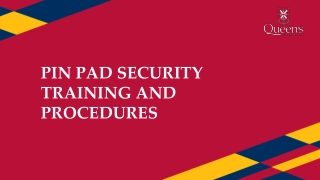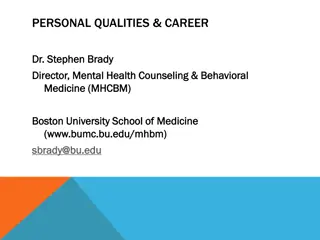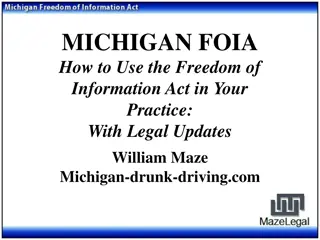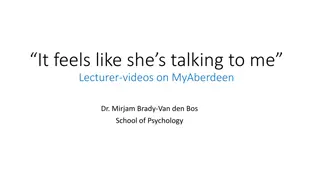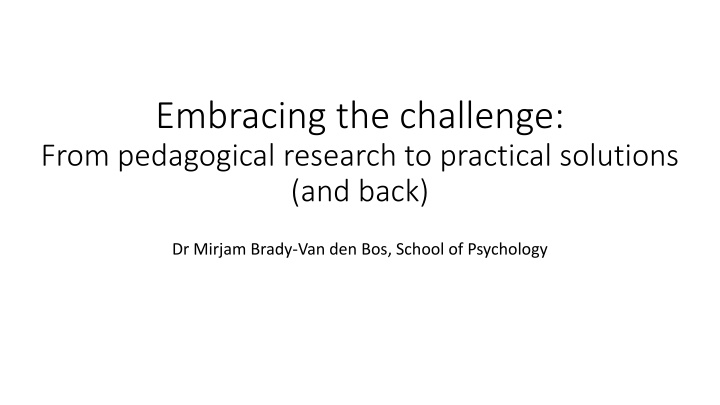
Enhancing Online Learning Through the Community of Inquiry Framework
Exploring the Community of Inquiry Framework by Garrison, Anderson, and Archer (2000) reveals key aspects such as Social Presence and Cognitive Presence that foster effective online learning environments. Social Presence focuses on building relationships and trust among participants, while Cognitive Presence emphasizes constructing meaning through discourse. By understanding these dimensions, educators can design more engaging and supportive online courses. The framework provides a structured approach for promoting interaction, preventing dropouts, and enhancing overall learning outcomes.
Download Presentation

Please find below an Image/Link to download the presentation.
The content on the website is provided AS IS for your information and personal use only. It may not be sold, licensed, or shared on other websites without obtaining consent from the author. If you encounter any issues during the download, it is possible that the publisher has removed the file from their server.
You are allowed to download the files provided on this website for personal or commercial use, subject to the condition that they are used lawfully. All files are the property of their respective owners.
The content on the website is provided AS IS for your information and personal use only. It may not be sold, licensed, or shared on other websites without obtaining consent from the author.
E N D
Presentation Transcript
Embracing the challenge: From pedagogical research to practical solutions (and back) Dr Mirjam Brady-Van den Bos, School of Psychology
A good place to start https://eric.ed.gov/ Search terms I used: online course design online course principles distance learning
What I found Many isolated studies looking at certain aspects of online learning how long should a video be how to run a discussion board case studies about a problem-based online class case study of dropout prevention strategy etc. These are helpful, but it s better to have an overarching framework, a paradigm
Eventually, I found one, mentioned in the Introductions of several studies: The Community of Inquiry Framework Castellanos-Reyes, D. 20 Years of the Community of Inquiry Framework. TechTrends, 64, 557 560 (2020). https://doi.org/10.1007/s11528-020-00491-7 Evidence-based framework that specifies how all the elements of an online learning environment work together to create an effective learning climate.
Community of Inquiry (Garrison, Anderson & Archer, 2000)
Social Presence The extent to which participants (staff and students) in the community can project their personal characteristics into the community, presenting themselves as real people. There are 3 dimensions of Social Presence, based on students needs as they move through the course: a.Developing their identity as a Psychology student b.Communicating purposefully in a trusting environment c. Building interpersonal relationships (friendships) Functions: 1.Support Cognitive Presence (discussions work better if people can be real with one another and when there is trust) 2.Prevent drop-out (students need to find the interactions in the group rewarding and personally fulfilling)
Cognitive Presence The extent to which students can construct and confirm meaning through sustained discourse (with each other and with staff). There are 4 phases, which have most chance of being worked through by students in this order if the teaching framework is designed with logical flow: 1.Triggering event (learners recognize there is a problem and have a sense of puzzlement) 2.Exploration (learners use different sources and discuss with one another to understand things better) 3.Integration (learners reflect on information gathered, link ideas and try to come up with solutions) 4.Resolution (learners apply knowledge created to new situations; test solutions or defend them)
Teaching Presence The extent to which social and cognitive presence are supported through: Design of the educational experience (selecting, organizing, presenting course content, learning activities and assessments) Facilitation (setting a climate for learning, encouraging discussion, drawing everyone in) with the ultimate aim to realize learning outcomes.
Cognitive Presence Social Presence Checklist: describe what either staff or students (or both) are doing to meet each criterion Checklist: describe what either staff or students (or both) are doing to meet each criterion Staff Students Staff Students Participants feel secure to express themselves freely (open communication) A problem is presented Participants explore together Participants trust one another (interpersonal interaction) Participants engage with teaching content There is a sense of group identity (cohesion) Students use what they have learned to come up with solution Students can successfully collaborate (cohesion) Students apply what they have learned to new situation Participants feel free to express emotions Students know who staff are Teaching Presence Other Checklist: describe what either staff or students (or both) are doing to meet each criterion Checklist: describe what either staff or students (or both) are doing to meet each criterion Staff Students Staff Students There is a logical flow of course materials (topics, difficulty) Navigation on the course page is logical There is a logical flow of assignments (formative, summative, building on one another) There is immediacy Learning is encouraged Discussion is encouraged Everyone is encouraged to contribute
Cognitive presence: participants explore together How do you make that happen? Drawing from case studies: Comber., D. P. M, & Brady-Van den Bos, M. (2018). Too much, too soon? A critical investigation into factors that make Flipped Classrooms effective. Higher Education Research and Development, 37(4), 683-697 Students learn from explaining things to peers Especially when it follows on from individual study Pelz, B. (2007). (MY) three principles of effective online pedagogy. Journal of Asynchronous Learning Network, 8, doi10.24059/olj.v14i1.1642.
This is what I came up with, rooted in evidence but novel to my course: Students prepare for class individually (instruction sheet on MyAberdeen) sheet on MyAberdeen) Students prepare for class individually (instruction Students put class learning into practice on Discussion Board (1%) Students interact with others in class (class shortened to 1 hour) Familiarization with material, having questions Practise helping other students with their questions Post 1, answer 2 (no tutor intervention)
(What the discussion board looks like) Post 1, Respond to 2 (this is a requirement) Example 1. Forum Task related to assignment about 'getting to grips with reading scientific articles' The instructions for students are: Below, start a new thread, asking for help with a particular thing you are not sure of. It has to be about the content of the articles themselves, not about the mechanics of downloading articles etc. (You can still ask these questions, but simply email them directly to me). Formulate your question as clearly as possible. Then, look through the list of questions and respond to (at least) 2 of them. Try not to give a direct answer, but help the person to find the answer themselves, by giving hints or asking further questions.
How I plan to evaluate this approach I am interested in the effects this approach has on how students learn (not necessarily whether their grades go up) Qualitative interviews One to one, Teams, with a Level 3 student interviewer Probably Grounded Theory
Social presence: students know who staff are How do you make that happen? Drawing from our own case study: Brady-Van den Bos & Comber (in prep). It feels like she s looking at me explaining assignments using lecturer videos Students feel as if they know a lecturer better if these include their face in the teaching videos Elsewhere: large body of what students prefer literature suggesting that students like videos that show the lecturer alongside the slides and appear spontaneous ; usually studies don t explain why.
This is what will happen on my course: Teaching staff show their face as much as possible Welcome video Weekly Chat with Mirjam (live, BB collaborate), All lectures recorded with face showing Assignment videos with tutor face Everything is recorded in a single take (no endless rehearsals to make it perfect )
How I plan to evaluate this approach I am interested in testing aspects of the Community of Inquiry framework I will compare students experience of watching lecture videos with and without the tutor face (they take other courses that may not include faces in videos) I want to measure the effect of the videos on: - How close they feel to the lecturer - Whether (and to what extent) it helps them feel socially present themselves - Their motivation for the course
In sum Start with the pedagogical literature, however tempting it is to just try out your own ideas (It s possible to refit a theoretical rationale to your approach afterwards, as sometimes intuition is in fact a forgotten article in your mind) After implementation, evaluate it you then have started a line of pedagogical research that you can drawn from and build on in years to come (and be invited to give talks about ;-))



